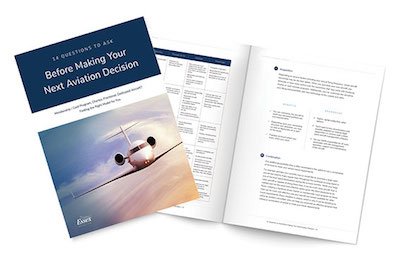
An international flight can be either an adventure or a headache, depending on who you ask. For those eager to depart to exotic locales on their next vacation, a transatlantic flight might seem like a minor obstacle to overcome — but for frequent business fliers, long-haul flights are just part of the job. The good news is, flying private can turn even a 20-hour flight from New York to Sydney — the longest in the world — into a positive experience by providing all of the creature comforts of home.
If you’re reading this, you’re likely already familiar with the benefits of flying private: the luxury of being able to sit wherever you want, with ample room to make yourself comfortable; the ability to enjoy specially prepared meals while flying at an altitude above the airlines; the freedom to work while en route to your destination without having to worry about the prying eyes or ears of nosy seat neighbors… The list goes on. From a purely practical perspective, similar to domestic private flights, international private flights also provide you with access to a wider variety of airports, often with private terminals and less inbound and outbound traffic, which may have more efficient security and customs clearance services. All of these benefits will enable you to minimize the amount of time necessary for your scheduled departure and arrival to meet the requirements of your busy schedule.
With all of that said, there are unique considerations to flying private internationally — things you should know before you make the decision to shift your current travel providers or look into international private jet charter.
Popular International Private Jet Routes & Airports
According to the Knight Frank Group’s 2019 Wealth Report, the most popular international private jet routes are as follows:
- Cannes (Nice-Côte d’Azur) to Paris (Le Bourget) — 1,874 flights
- Miami to the Bahamas — 1,577 flights
- London (Luton) to Paris (Le Bourget) — 1,427 flights
- New York (Teterboro) to the Bahamas — 1,295 flights
- Moscow (Vnukovo Intl.) to Cannes (Nice-Côte d’Azur) — 1,192 flights
- New York (Teterboro) to London (Luton) — 423 flights
- Geneva (Cointrin) to Moscow (Vnukovo Intl.) — 369 flights
- Paris (Le Bourget) to New York (Teterboro) — 336 flights
Perhaps unsurprisingly, the vast majority of international private jet flights depart from or arrive into North America and Europe. Regardless where you’re headed, most countries have multiple airports that can be utilized by private aircraft, providing passengers flying private with more options to land closer to their final destination.
How long your flight takes depends entirely on your route. A flight from New York to Sydney will obviously take longer than one from New York to London (which are approximately 20 hours and 7 hours, respectively), but modern private aircraft come equipped with advanced avionics technology, such as the Future Air Navigation System, which enable them to take more efficient routes. Depending on the length of your journey and model of the private aircraft you’re flying in, it’s entirely possible that you’ll have to stop to refuel or change flight crew per the Federal Aviation Administration’s Pilot Fatigue Rules.
The Cost of Flying Private Internationally
Similar to the length of travel time, the cost of an international private jet flight depends on a number of different variables, including the aircraft model, whether you own your aircraft or intend to charter a flight, where you’re flying to and from, which countries you’re flying over (many countries impose overflight fees, require permits or cannot be overflown), fuel requirements, crew resources, general fees and more.
Working With an International Operations Group
With all of that said, if you’re in a position to afford flying private internationally, you should be more concerned with planning than with costs. For example, let’s say you were planning a trip from Boston to Hong Kong — a nearly 16-hour, 7,950-mile flight. In order to organize that trip, you’d first need to find the right aircraft for the mission; which aircraft you use is dependent upon a few different factors, including the range of the flight and the number of passengers you’ll be traveling with.
Due to the length of the flight time, you’ll also need to take crew duty time into consideration. For example, a two-pilot crew is limited to 10 hours of flight time, and a three-pilot crew to 12 hours. With 16 hours of flight time, your operator will need to schedule a fuel stop to perform a crew change. You’ll also need to decide whether it makes sense to arrange accommodations for crew members at the fuel stop location so that they can wait and prepare for the return flight, depending upon the total duration of the trip.
If you’re flying with a group and intend to eat onboard, it might make sense to hire one or more professional cabin attendants to provide cabin services during the flight, especially when it comes to sourcing and preparing food and managing other amenities.
In addition to these considerations, your operator will also need to:
- Secure the proper permits. Some countries require overflight permits — that is, approval from a country’s regulatory authorities to fly over it. Most countries also require landing permits; some even require that individual permits be obtained for different airports within the same country. Fortunately, it’s far easier to secure landing permits for a private operation than a commercial one, which adds to the appeal of international private jet travel.Another key thing that operators must consider when arranging international flights for clients is whether a trip is being flown Part 91 (owned flight) or Part 135 (charter flight). Since charter flights are more heavily regulated than owner flights, if you intend to travel internationally via a private jet, your operator will need to secure additional permits.
- Be mindful of cabotage. When it comes to flying private internationally, cabotage is a major concern. Although the definition of cabotage varies slightly from one organization to the next, the Aircraft Owners and Pilots Association defines it as rules that:
“Prohibit foreign aircraft from one country traveling into another country and picking up foreign nationals or citizens of the other foreign country and providing transportation to and between points within that foreign country.”
For example, according to the rules of cabotage, AirFrance couldn’t fly into the United States, pick up passengers in New York and fly them to Los Angeles unless it were the continuation of an existing trip. International private jet operators who violate the rules of cabotage are subject to penalties, so it’s important that they carefully evaluate which passengers will be on board each flight, and whether those passengers have the proper documentation (such as an ESTA visa or a VWP Signatory Carrier) so that they can receive authorization from each particular country.
- Assemble a safety and security briefing. Prior to any international private jet trip, an operator will put together a safety and security briefing not only for the aircraft, but for the passengers and crew members, as well. This briefing should include a complete evaluation of the country and city to which you’re traveling. This evaluation will include an assessment of:
- Recent issues within that country
- Current medical conditions
- What vaccinations passengers and crew members require
- Which lodging is safest
- What areas to avoid
- How to protect the aircraft
- And so on
Your international private jet operator will offer recommendations based on their findings. For example, depending on the risk, they might contract a third-party company to provide security and oversight of the aircraft during the trip.
- Outline associated fees. With everything from handling fees to customs and immigrations fees, an operator can clearly outline the total cost of your international flight. They should also be able to explain the nuances around navigational fees, which vary from country to country.
As you can see, planning international private jet travel can be quite a complicated affair, which is why it’s in your best interest to retain the services of an international operations group. If you or your company already own an aircraft, your management company or in-house flight department may already utilize the services of one of the major third-party international flight service vendors such as Universal Aviation or ARINCDirect.
Make the Switch With Essex Aviation
As you can see, there’s a great deal of complexity around flying private internationally on a trip-by-trip basis — complexity best managed by an experienced international handling company, as mentioned. However, if an increase in international travel has led you to reconsider whether your current aircraft model or existing infrastructure (either your management company or in-house flight department) sufficiently meets your needs, it might be time to bring in an expert. An experienced private aviation consultant can help you better understand the precise challenges posed by international travel and can work with you to find a solution to help you overcome them.
If you’re interested in making the transition from flying private domestically to internationally, Essex Aviation is here to help you get started. Whatever your travel needs or requirements, the consultants at Essex Aviation bring over 70 combined years of aviation experience and industry connections to the table, which we leverage to ensure an exceptional private aviation experience. To get started on your journey, contact Essex Aviation today.







